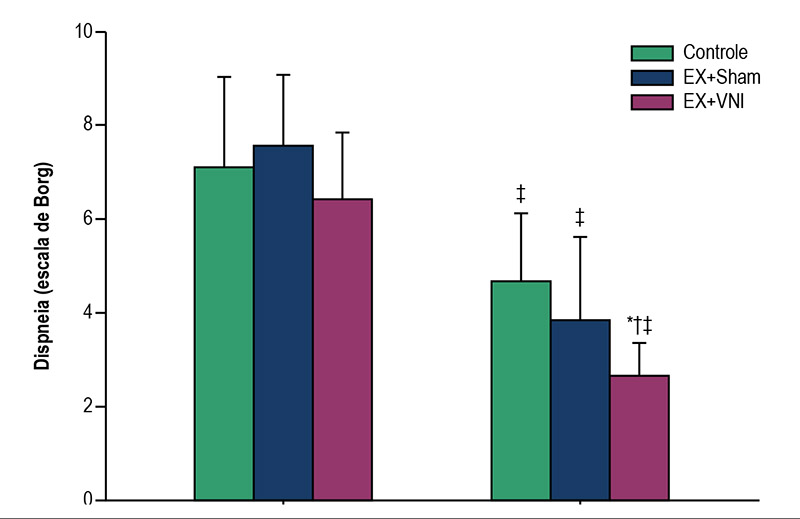Volume 110, Nº 5, May 2018
DOI: http://www.dx.doi.org/10.5935/abc.20180039
ARTIGO ORIGINAL
Safety and Efficacy of Aerobic Exercise Training Associated to Non Invasive Ventilation in Patients with Acute Heart Failure
Mayron F. Oliveira
Rita C. Santos
Suellen A. Artz
Vanessa M. F. Mendez
Denise M. L. Lobo
Edileide B. Correia
Almir S. Ferraz
Iracema I. K. Umeda
Priscila A. Sperandio

Figure X1 – Dyspnea Borg scale at first day of hospitalization (D1) and at last day of protocol (D10) in Control, Exercise Training (ET) + Sham and ET+non-invasive ventilation (NIV) groups. Notes: * p < 0.05 vs. Control; † p < 0.05 vs. ET+Sham; ‡ p < 0.05 vs. D1.
Abstract
Background: Exercise training (ET) improves functional capacity in chronic heart failure (HF). However, ET effects in acute HF are unknown.
Objective: To investigate the effects of ET alone or combined with noninvasive ventilation (NIV) compared with standard medical treatment during hospitalization in acute HF patients.
Methods: Twenty-nine patients (systolic HF) were randomized into three groups: control (Control - only standard medical treatment); ET with placebo NIV (ET+Sham) and ET+NIV (NIV with 14 and 8 cmH2O of inspiratory and expiratory pressure, respectively). The 6MWT was performed on day 1 and day 10 of hospitalization and the ET was performed on an unloaded cycle ergometer until patients’ tolerance limit (20 min or less) for eight consecutive days. For all analyses, statistical significance was set at 5% (p < 0.05).
Results: None of the patients in either exercise groups had adverse events or required exercise interruption. The 6MWT distance was greater in ET+NIV (Δ120 ± 72 m) than in ET+Sham (Δ73 ± 26 m) and Control (Δ45 ± 32 m; p < 0.05). Total exercise time was greater (128 ± 10 vs. 92 ± 8 min; p < 0.05) and dyspnea was lower (3 ± 1 vs. 4 ± 1; p < 0.05) in ET+NIV than ET+Sham. The ET+NIV group had a shorter hospital stay (17 ± 10 days) than ET+Sham (23 ± 8 days) and Control (39 ± 15 days) groups (p < 0.05). Total exercise time in ET+Sham and ET+NIV had significant correlation with length of hospital stay (r = –0.75; p = 0.01).
Conclusion: Exercise training in acute HF was safe, had no adverse events and, when combined with NIV, improved 6MWT and reduce dyspnea and length of stay. (Arq Bras Cardiol. 2018; 110(5):467-475)
Keywords: Exercise; Acute Heart Failure; Non-Invasive Ventilation; Physiotherapy; Rehabilitation.















